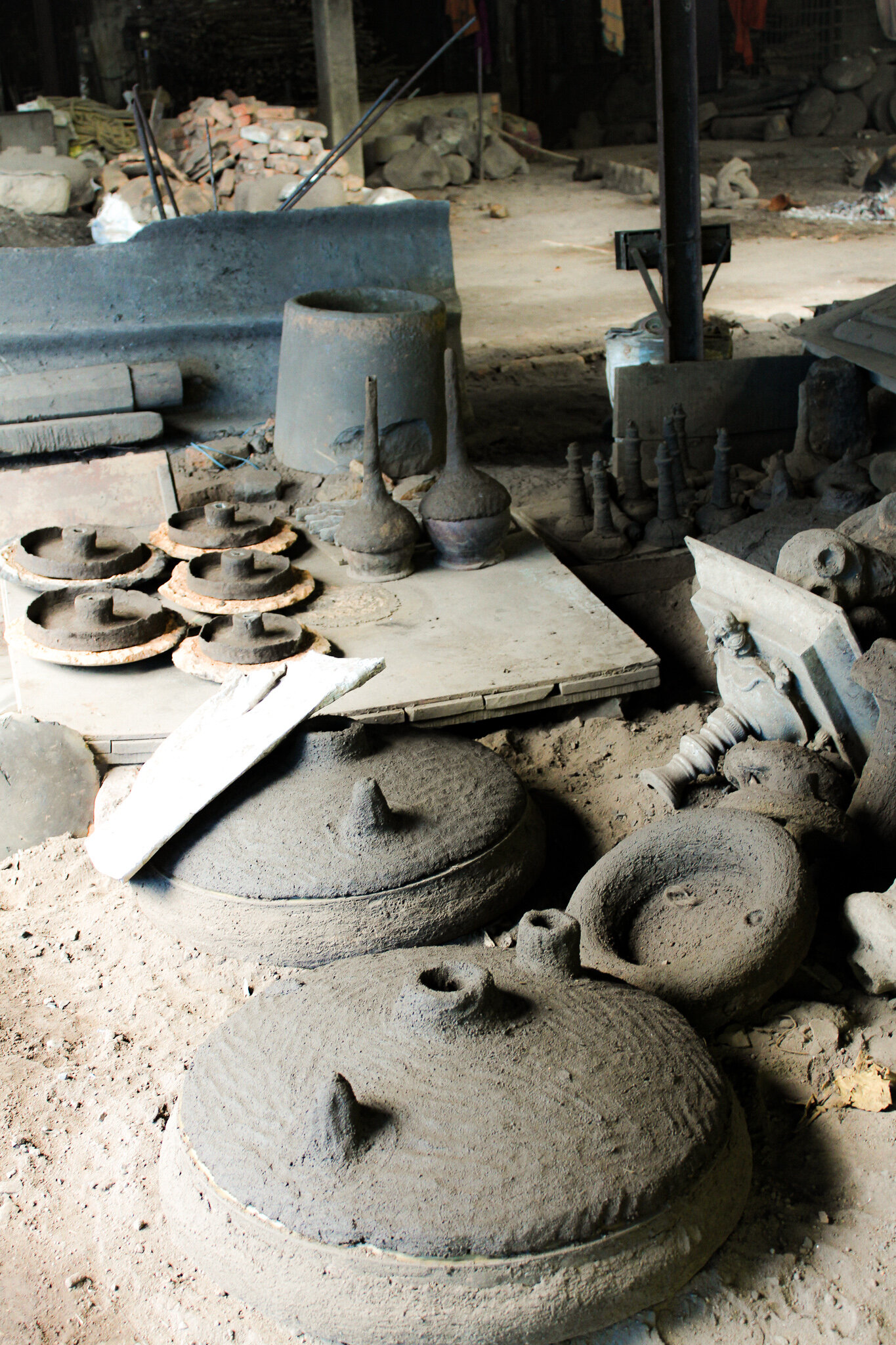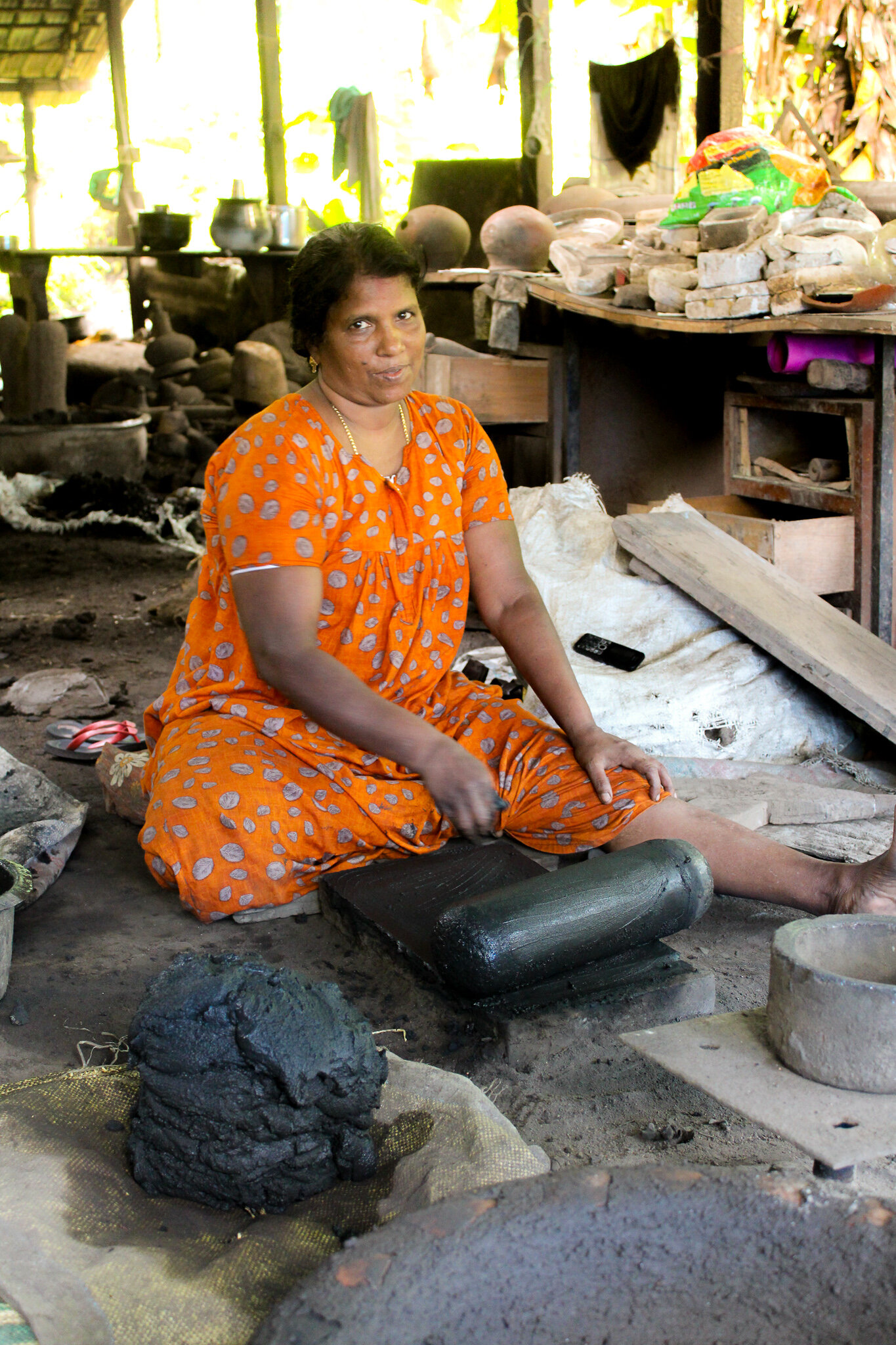The Caste Stories Behind Kerala's Traditional Cookware

Diya Joseph writes about the history Kerala’s metal industry and its inextricable links to caste and oppression.
This story has its roots in Mannar, Kerala, a town like any other, except for its persistent fumes and sweltering workshops, home to a working class skilled in the craft of metal and alloy, the creators of to Kerala’s most widely-recognised kitchen utensils — the uruli, varpu, kinnam and ottukalam. The uruli was used for cooking and serving food, given its high capacity to retain heat, and its ability to preserve the flavour of food cooked in it. In the recent past, this kitchen-utensil-turned-artefact has become a ubiquitous addition to luxury hotel lounges, a prop to amplify the culture quotient of the brand.
The varpu, a cauldron made of bronze, was traditionally a sign of celebration, emerging from dusty attics to cook large quantities of food, or Ayurvedic medicine. A close relative of the uruli, the varpu too, is now used primarily as a decorative element to hint at heritage. The bronze kinnam and ottukalam, once staples in every household in Kerala, to store food or water as they are wonderful insulators, have also lost their place.
Mannar town is referred to as the ‘Bell Metal Town’ of Kerala, thanks to the large number of merchants and labourers in the area. This town lives and breathes the art of metal melding; bronze in particular. Mannar’s soil is perfectly suited to this craft. Moulds are designed with clay, onto which molten wax is poured, to create an even coating. This is then left to cool and harden. This process culminates with molten metal alloys being poured into the cavity to create each piece. Once a thriving industry, passed on from generation to generation, its numbers have steadily dwindled. What was once 250 families is now a mere 20-30 families that practise the craft today. Falling demand, a labour-intensive craft, combined with poor financial returns, made it seem like decline was inevitable.
The moulds left to dry at the artisans workshop in Mannar.
The clay being made to create the moulds for the artefacts.
The few remaining establishments in Mannar can be traced back to a century of skill and tradition. The town gained renown in both national and international forums thanks to the bronze statue of Shiva from Kerala, displayed at the Metropolitan Museum of Art, New York, and the massive Cathedral Church of Redemption Bell, which resounds through the streets of New Delhi.
But before we examine at the incredible craftsmanship of the artisans of Mannar, let us go further into the vestiges of an undocumented past, one in which these utensils embodied the voice of the subaltern, the marginalised ‘other’.
In a conversation with the older folk of my household, I heard an interesting anecdote. In the state of Kerala, the land of the communist, a beacon to the country in its literacy ratios, lie age-old customs, caste and disparity. Malayalis were divided based on caste, in both the Hindu and Christian communities; crudely, a divide between the ‘touchables’ and the ‘untouchables’. The untouchable, lower-caste ‘other’ were the Paravans, the Pelayas and the Pulayas, to name a few. They were often forbidden from accessing public roads, educational institutions or even covering their upper bodies, treated as though their very breath defiled the air. While the dominant upper-caste relished meals in fancy crockery (or, as was in vogue at the time, stainless-steel plates), these marginalised communities ate and drank in utensils like the kavadi kinnam, irumbu kinnam and ottu kinnam. They were formed with copper, bronze, iron or other alloys, and coated with baked enamel to prevent corrosion. Before these metallic utensils were introduced in the market, it was the clay mannchatti that was the bowl of the poor. These utensils were never touched by dominant classes. The kavadi kinnam and others were tainted crockery, polluted by its association with the Paravans, the Pelayas and the Pulayas. However, these utensils that were once thought of as inferior, were, in fact, made from expensive metals that lasted a lifetime. Funnily enough, the modern man who was expected to leave behind all traces of inequality, eats and cooks in aluminium cookware, known to release toxins under high temperature. Fate is a funny thing.
Going over historic narratives of caste and creed, the remarkable Land Reforms Act of Kerala (1969) created a diaspora of wealth among its inhabitants. The feudal system came crashing down as peasants were given legal power to own the land they cultivated, and the excess land belonging to feudal lords, was to be distributed among landless labourers. In essence, it marked the end of the feudal system and exploitation in the agrarian sector. This led to many in the marginalised periphery rising and gaining a foothold in economic development.
What does this cookware represent today? In Mannar, a proprietor in the area tell me they are ringing the end of an age of exploitation. “Owing to the attempt to bring back the past cultural milieu, the bronze metal industry is regaining momentum. There is a drastic shift in the utility of utensils and cookware from the living spaces and back to the kitchen. Uruli, varpu, kinnam and ottukalam that were once household essentials are now back in the vicinity of the kitchen.”
Irinjalakuda in Thrissur is another centre of talent that is home to several craftsmen specialised in bronze artefacts. Beyond the spectrum of cookware, these artisans create idols and other ornaments, their livelihood supported by corporates who commissioned works that they further distribute and sell. Kadavallur, located in the norther Thrissur, is yet another hidden gem that specialises in the bronze utensils of uruli and varpu, the craft preserved in a cluster of families that have been practicing over generations. The popularity of Kerala’s traditional cookware is not restricted to the boundaries of a town, or even the state. It has taken the country by storm. Even multi-cuisine 5-star hotels have embraced this ancient craft, hoping to weave some old-world charm into their narratives. The increase in demand is one that might save an otherwise dying industry.
Young entrepreneurs are rising from the ranks of Kerala to spearhead such movements. Green Heirloom a woman-led business is one that has earned growing recognition. The company incentivises artisans from across Mannar to curate beautiful collections of cookware, aiming to reinstate the integrity of the craft. Kinnam, uruli, mannchatti (clay pot), kalchatti (stone pot) and many similar products are part of the brand’s unique catalogue, specifically curated to customer specifications. A few other organisations that have ventured into the space of metallic cookware are Bellwics from Irinjalakuda, Nadavaramba from Thrissur, and PRM Metal Crafts from Mannar. Bellwics is a handicrafts Industrial Co-operative Society aided by the Department of Industry & Commerce in Kerala. The organisation focuses on the welfare of artisans, and aims to keep the rich tradition of Kerala’s craft alive. PRM Metal Crafts is a growing venture and a beloved brand under the patronage of PRM Lakshmana Iyer Associates, that specialises in bronze vessels, lamps and more. These artisans are proficient in the de-waxing method, making their products distinctive and high quality.
The traditional uruli from the workshops of Mannar, available at Green Heirloom
The narrative of the oppressor and the oppressed is ever-evolving, with varied facets of the truth. Kinnam and mannchatti are symbols of an oppressed era, that have been evoked in the contemporary environment to preserve a forgotten past. For this is the politics of people, “an un-historical historiography” of Kerala.
Diya Joseph is a postgraduate in Marketing, specialised in Consumer Behaviour from the University of Manchester, UK. She’s a keen writer, an amateur marketeer with a recent interest in baking. Her articles have been featured in The Week and The Hindu MetroPlus.
ALSO ON THE GOYA JOURNAL










